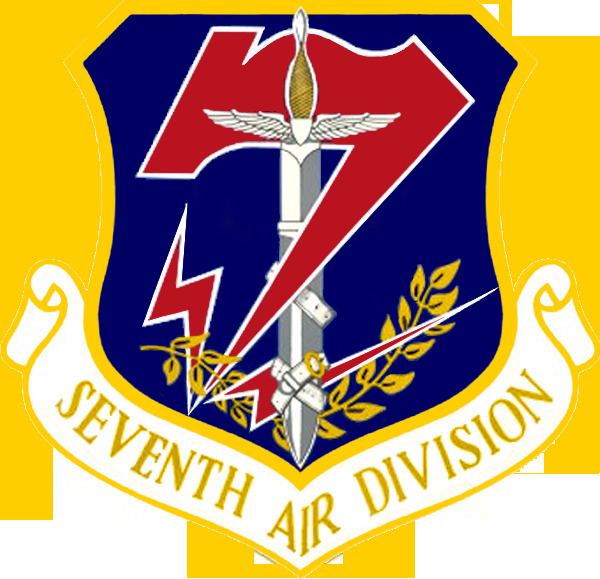 | ||
Active 1944-1948; 1951-1965; 1978–1992 Role Command of strike forces Equipment see #Aircraft section below Notablecommanders Gen John P. McConnellBrig Gen Wayne W. Lambert | ||
The 7th Air Division (7 AD) served the United States Air Force with distinction from early 1944 through early 1992, earning an outstanding unit decoration and a service streamer along the way.
Contents
Hawaii
The division provided air defense of the Hawaiian Islands April 1944 – September 1948.
Strategic Air Command rotation to England
Strategic Air Command (SAC) formed two air divisions in early 1951. The 7th Air Division was formed for its bases in England, while the 5th Air Division was and activated at Offutt Air Force Base, Nebraska, where Maj Gen Archie J. Old, Jr. formed its cadre before it moved overseas to control SAC units in Morocco. The 7th, led by Brig Gen Paul T. Cullen, was the first to deploy, leaving for England in March, but the Douglas C-124 Globemaster II aircraft carrying General Cullen and his staff crashed in the Atlantic, leaving no survivors. General Old hastily flew to England, where he took command of the 7th Division until Maj Gen John P. McConnell could arrive. Once a new commander was appointed in May, General Old and his staff left for Morocco.
The division controlled deployed bombardment and reconnaissance forces between 1951 and 1965. During the 1950s, SAC's presence in England grew, with nine bases being constructed for the use of SAC bombers, and another six throughout the United Kingdom for support of SAC activities. In 1953, shortly after the death of Stalin, the first Boeing B-47 Stratojets, from the 306th Bombardment Wing, arrived in England for 90 days duty, beginning what would be known as Reflex operations in the United Kingdom.
On 26 July 1956, a Boeing B-47 Stratojet under the division's operational control was practicing touch-and-go landings at RAF Lakenheath crashed into a nuclear weapons storage facility causing damage to several weapons stored at the site.
It participated in alerts, exercises, operational readiness inspections, evaluations, and intensive training programs to provide an advanced combat ready force. It also assumed responsibility for air base construction and improvement, which included building complexes to accommodate bombers, fighters, and special functions such as communications, weapons storage, aircraft parts, and navigational aids.
In September 1957, B-47s in Morocco were put on ground alert, armed, fueled and ready to take of upon notice. This posture was expanded to the bases under the 7th Air Division's command in early 1958. For the remainder of the division's existence, this status, known as Reflex Action (usually shortened to just Reflex), would be the normal status for the Stratojets rotating through England. The number of 7th Air Division bases used for Reflex reached a peak of nine in early 1959.
The development of Intermediate Range Ballistic Missiles by the Soviet Union made forward bases for SAC medium range bombers increasingly vulnerable. After 1958, when the 100th Bombardment Wing departed RAF Brize Norton, SAC bombardment wings no longer rotated as entire units, although six bombers continued on alert at each of the division's bomber bases. The number of B-47 wings capable of sending aircraft to Reflex operations at the division's bases began to decline after 1958. The replacement of the medium bomber by the heavy bomber and the intercontinental ballistic missile in the SAC inventory continued into the early 1960s and this removed the need for SAC bases in England, leading to the inactivation of the division in June 1965.
Strategic Air Command in Europe
From 1978, the division was activated in Europe to provide command and control for SAC units assigned to USAFE, primarily air refueling and reconnaissance organizations, but also ground support units such as the 3920th Strategic Wing. It assured that assigned units trained to conduct strategic warfare according to the Emergency War Order. It also assured that assigned units could conduct strategic reconnaissance and air refueling and function as the nucleus of a SAC advanced echelon in event of contingency operations.
7th Air Division in Desert Shield/Desert Storm
Source: Gulf War Air Power Survey Vol V., 21-25.
Lineage
Assignments
Components
Wings
Groups
Squadrons
Stations
Aircraft
After activation on 1 July 1978, the division controlled aircraft such as the: KC-135 Stratotanker, B-52 Stratofortress, RC-135V/W Rivet Joint, SR-71 Blackbird, and U-2 Dragon Lady.
